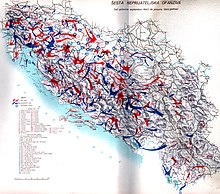|
Operation Kugelblitz
Operation Kugelblitz (German: Unternehem Kugelblitz) was a massive counter-insurgency operation by the German 2nd Panzer Army conjunction with collaborationist forces against the Yugoslav Partisans around the eastern Bosnian region of the Independent State of Croatia during World War II. Launched on 3 December 1943, the objective of Kugelblitz was to encircle and destroy Partisan positions around the eastern part of the NDH, who were planning to regroup in occupied Serbia. The events of Operation Kugelblitz are associated with the Sixth Enemy Offensive (Serbo-Croatian: Šesta neprijateljska ofenziva). The operation was divided in two phases as dictated by the codename Kugelblitz (German: Ball Lightning). The first phase (Ball) was to quickly overwhelm and encircle enemy forces and the second phase (Lightning) was to destroy the Partisans. The ground forces consisted of Wehrmacht and Waffen SS divisions, particularly the 2nd Panzer Army and the 7th SS Volunteer Mountain Division Prinz Eugen in addition to Home Guard forces of the NDH and Chetniks. The Axis were able to recapture Tuzla and Bihać, but the Partisans were able to avoid encirclement despite heavy casualties. Several factors to the failure of the operation included the swift maneuvers of the Partisan forces and fierce resistance around the region. BattleOperation KugelblitzOperation Kugelblitz, the first of the two offensives, was executed by the 5th SS Mountain Corps. The aim of this operation was to dismantle and consequently destroy Partisan units in eastern Bosnia. The operation ultimately was unsuccessful because the German forces were unable to completely destroy all the Partisan troops. Because of the terrain, large area, and lack of Axis manpower to adequately cover the encirclement, Partisan forces evaded complete destruction by slipping through large gaps in the narrowing encirclement. However, the Partisans still suffered severe casualties. Operation SchneesturmOperation Schneesturm was initiated immediately upon the completion of Operation Kugelblitz. This operation included twin drives from the Bosnia area. One drive headed westwards towards the Adriatic Sea. The other headed to the northwest and towards the border with Italy. While this operation ended late in December and the Partisans once again survived, the cost was high. The Partisans suffered about 2,000 additional casualties. Although badly battered, the majority of the Partisan units retained their cohesion. Tito's army, in the opinion of some, could still be considered an effective fighting force. Results
ReferencesSources
See also |
||||||||||||||||||||||||||||||
